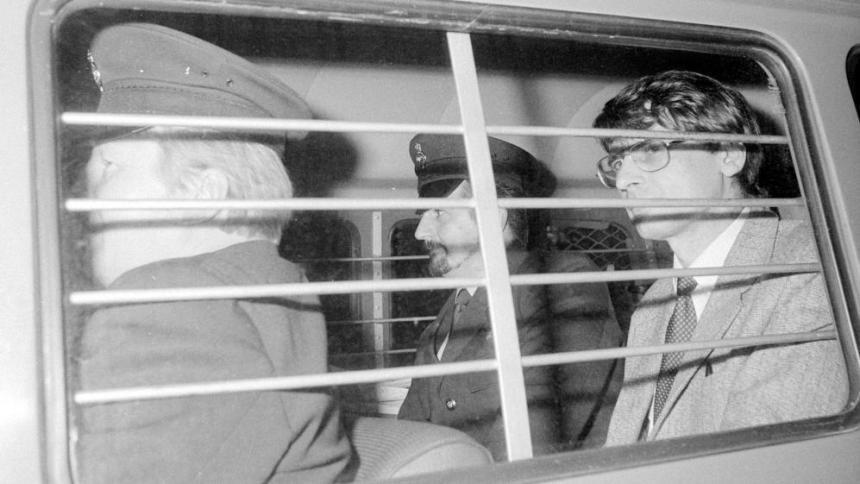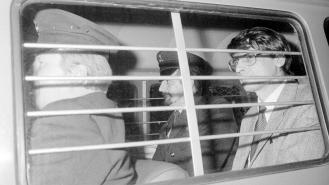
How homophobia helped Dennis Nilsen get away with murder
For a murderer so prolific he has been branded Britain’s second worse serial killer, who was able to murder up to 15 men between 1978 and 1983, it is remarkable that the crimes of Dennis Nilsen—who is the subject of new drama Des—was only discovered after his neighbours complained about their blocked drains.
Despite the fact Nilsen was known to police, his arrest and confession only came after a plumber, who was called in to investigate the pipes near Nilsen’s Muswell Hill home, discovered human remains Nilsen had tried to flush.
Why he wasn’t caught earlier? Maybe it has to do with the victims he preyed upon and the police’s attitude towards them.
For years, Nilsen targeted the vulnerable: young men and boys (some as young as 14) who were part of groups that police have historically been accused of ignoring: most were gay, many were homeless and runaways and some were involved in sex work. When allegations against Nilsen surfaced, they were seemingly disregarded and dismissed by police, who wrote them off as ‘gay crimes’. Can police homophobia account for the reason Nilsen wasn’t caught sooner? It seems so.
In 1980, Douglas Stewart woke up in Nilsen’s home to find Nilsen attempting to strangle him. Stewart managed to escape and alert the police, showing them the marks on his neck. Yet despite that, police dismissed it as a ‘homosexual lover’s tiff’.
Carol Stottor also reported Nilsen to the police, after Nilsen suffocated him while he was staying at Nilsen’s home. (Nilsen later resuscitated him and allowed him to leave.) But Stottor wasn’t contacted again until Nilsen had already been arrested—following a confession.
Innate homophobia runs through this case. Paul Nobbs testified that he never reported his own encounter with Nilsen to police for fear of his sexuality being discovered. And Nilsen himself was a victim of homophobia: homosexuality was still illegal when he was growing up in Scotland and he later left the army because of the homophobia he encountered there.
It’s not a complaint unique to this case. The same allegations of police prejudice, which have in turn led to inaction or negligence, occurs in other cases that affect the LGBTQ+ community, the killers benefiting from the fact that their victims are part of a stigmatised group.
It’s not a complaint unique to this case. The same allegations of police prejudice, which have in turn led to inaction or negligence, occurs in other cases that affect the LGBTQ+ community, the killers benefiting from the fact that their victims are part of a stigmatised group.
One of Jeffrey Dahmer’s victims, 14-year-old Konerak Sinthasomphone— who had been drugged and attacked by Dahmer, before managing to escape—was even returned to Dahmer by police, despite the fact he was cut, bleeding and naked. Dahmer was already on probation following a second-degree assault on a 13-year-old boy and had the bodies of other victims in his home when the police entered it. But police concluded it was a ‘lover’s quarrel’, describing the then 31-year-old as Sinthasomphone’s ‘boyfriend’ and laughing about the entire incident. Sinthasomphone was murdered soon after they had left.
Police also knew of Bruce McArthur, the prolific killer behind the murders of men from Toronto’s gay village between 2010 and 2017—the disappearances of whom the gay community had already accused police of not taking seriously—after he attacked a gay sex worker with a metal bar in 2002. Relations, in fact, were so bad between police and the LGBTQ+ community that uniformed officers were banned from Pride Toronto in 2017 and 2018.
Police in Los Angeles faced similar accusations over the case of Ed Buck, who was able to murder Black gay men for years without repercussion. His victims were often homeless and addicted to drugs. One victims’ mother said she was treated by police like a criminal, accusing them of ignoring evidence, as well as the men who spoke out.
The UK’s police force also continues to be called out for its negligence when it comes to crimes affecting gay men.
‘Gay Slayer’ Colin Ireland murdered five men in three months before he was arrested. Despite similarities between the bodies and the fact that he met all of his victims at the same pub, police were slow to connect the deaths. Ireland even started leaving clues for the police at the scenes. His arrest came only after he turned himself in.
Ireland’s case was mentioned in a 2007 report that found that ‘institutional homophobia’ had hampered Scotland Yard’s reactions to attacks and murders of gay, lesbian and trans people. A lack of knowledge, reliance on stereotypes and personal prejudice were quoted as being behind the failures.
Though it noted progress had occurred since the 90s, when Ireland was operating, the same mistakes continue to be made, as was the case in 2014, with Grindr Killer Stephen Port.
Despite the fact that they had been warned by the Met’s LGBT independent advisory group that a serial killer was at work, police failed to connect the deaths of Port’s victims, which were taken as suicides or drug overdoses. Similarly to Nilsen, Port was known to police for his involvement in the death of one of the men, Anthony Walgate. His computer had even been seized, but police failed to search it. If they had, they would have found disturbing online searches. Victims’ families later sued for the homophobia they said stopped the police from connecting the victims’ deaths and which led to more murders.
As recently as last year, the BBC reported that prosecution by police for hate crimes was falling, despite the fact that the numbers of victims coming forward was on the rise, with victims quoted in the piece stating police had done little to investigate their cases. And gay officers within the force have also backed up the allegations of innate homophobia.
So what can be done to ensure that police homophobia is tackled? There are no easy answers, especially when prejudice is so deep rooted—both in individuals and the force as a whole. Cases like Port’s, though, highlight that the sexuality of LGBTQ+ victims continues to be taken into account in a way that isn’t true of straight victims. While that continues, so will inequality in the justice system.





